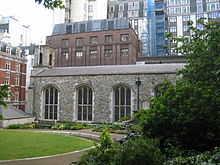| King's Chapel of the Savoy | |
|---|---|
 View of the associated green and the chapel's east side, from Savoy Street | |
| 51°30′38″N 0°07′12″W / 51.5105°N 0.1199°W | |
| OS grid reference | TQ 30568 80743 |
| Location | Liberty of the Savoy, near Temple, London |
| Country | England |
| Denomination | Church of England |
| Previous denomination | Lutheran Catholic |
| Website | royalchapelsavoy |
| History | |
| Status | Royal Peculiar |
| Architecture | |
| Functional status | Active |
| Architect(s) | Richard Griffiths Architects (renovations)[1] |
| Style | Tudor; Perpendicular |
| Completed | 1512 |
| Specifications | |
| Length | Nave: 200 ft (61 m) |
| Number of towers | 1 |
| Materials | Stone |
| Administration | |
| Province | Canterbury |
| Diocese | London (location) |
| Clergy | |
| Chaplain(s) | Rev. Canon Thomas M B Woodhouse |
| Laity | |
| Director of music | Philip Berg |
| Organist(s) | Justin Luke |
Listed Building – Grade II* | |
| Official name | Savoy Chapel (King's Chapel of the Savoy) |
| Designated | 24 February 1958 |
| Reference no. | 1264731[2] |
The King's Chapel of St John the Baptist in the Precinct of the Savoy, also known as the King's Chapel of the Savoy (called The Queen's Chapel during much of modern history in the reigns of Victoria and Elizabeth II), is a church in the City of Westminster, London. Facing it are 111 Strand, the Savoy Hotel, the Institution of Engineering and Technology and – across the green to its side – the east side of Savoy Street. The chapel is designated as a Grade II* listed building.[2]
The chapel sits on the site of the Savoy Palace, once owned by the prince John of Gaunt, that was destroyed in the Peasants' Revolt of 1381. Gaunt's Duchy of Lancaster, the owner of the site of the palace, eventually came into the hands of the monarch. Work was begun on the chapel in 1502 under King Henry VII and it received its first charter to operate as a hospital foundation in 1512 to look after 100 poor and needy men of London. The hospital had fallen into ruin by the late 18th century; only the chapel survived the consequent demolition, which as to the hospital's eastern end was ceded for an approach to Waterloo Bridge.
The chapel is still owned by the Duchy of Lancaster and as such is a Royal Peculiar – outside the jurisdiction of a diocese, but under that of the reigning monarch. It is the chapel of the Royal Victorian Order, whose full gathering takes place at St George's Chapel, Windsor Castle, to accommodate those numbers. In 2016, the church was brought under the Chapel Royal for ecclesiastical purposes.
- ^ "www.rgarchitects.com".
- ^ a b Historic England. "Savoy Chapel (1264731)". National Heritage List for England. Retrieved 10 November 2016.
